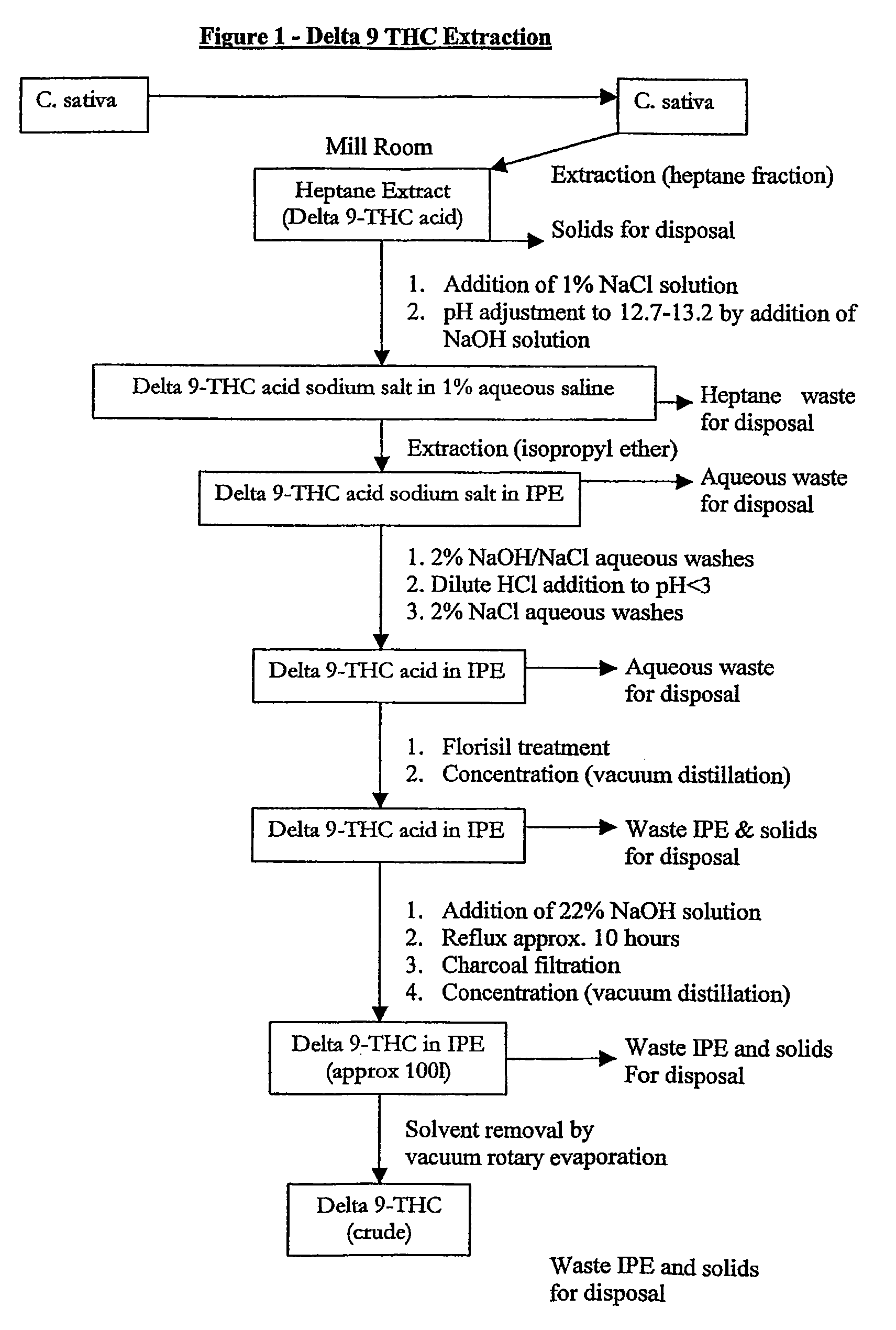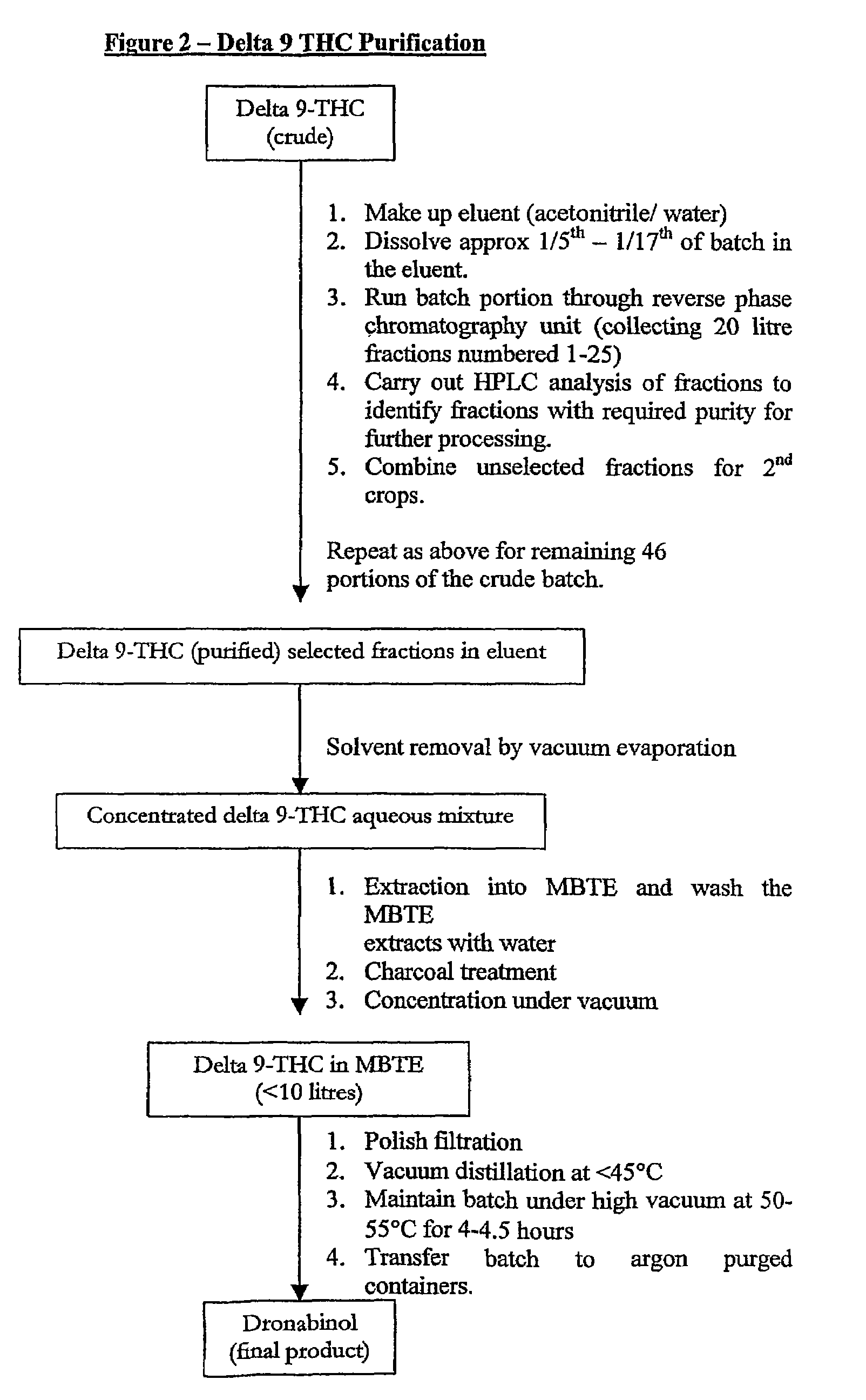Production of Δ 9 tetrahydrocannabinol
a technology of tetrahydrocannabinol and tetrahydrocannabinol, which is applied in the direction of magnoliophyta medical ingredients, plant ingredients, biocide, etc., can solve the problems of large number of purification steps, high cost of column chromatography, and difficulty in achieving the effect of reducing the level of plant material, reducing the number of steps, and good results
- Summary
- Abstract
- Description
- Claims
- Application Information
AI Technical Summary
Benefits of technology
Problems solved by technology
Method used
Image
Examples
example 1
Selection of Plants
[0049]An analytical screening programme of Cannabis sativa was devised consisting of two phases.
[0050]Phase 1 involved the growing of 247 plants from seed and, after 4-6 weeks, analysis of leaf sections of the plants by GC for impurity profile and Δ9-THC content. Under the GC operating conditions all Δ9-THC carboxylic acid decarboxylates to Δ9-THC on the column. Based on the phase 1 analysis, a reduced number of plants were selected (24 in total) to progress to the next phase.
[0051]Phase 2 of the programme involved analysis of the 24 selected plants once flowering had begun. The individual flowering heads were ground and mixed thoroughly to obtain homogeneous material and analysis of the homogenised flowering heads was carried out in duplicate by GC.
[0052]Selection of the desired clone plant was carried out based on product yield and impurity profile.
[0053]Phase 1 of the selection process was undertaken over a 5 week period. Sample preparation and GC analytical me...
example 2
Extraction
[0057]This eraction is described with reference to FIG. 1.
Milling of Cannabis Sativa / Extraction with Heptane Fraction
[0058]Cannabis sativa (125 kg, leaf and flowering head) is milled using shredders. The milled material is then charged to a nitrogen purged vessel followed by hepatne fraction (1250 litres). The contents are stirred for 4-4 ½ hours under a low flow of nitrogen at ambient temperature (15-25° C.) then filtered. The filter cake is sucked dry for 30 minutes then the extracted plant material dug off the filter and recharged to the vessel. Heptane fraction (625 litres) is charged and the vessel contents stirred for 30 minutes at ambient temperature (15-25° C.) then filtered. Again the filter cake is sucked dry for 30 minutes. The heptane fraction extracts are combined.
pH Adjustment
[0059]A 1% w / v aqueous solution of sodium chloride is prepared (375 litres) and added to the vessel containing heptane fraction extract, and the vessel contents stirred for 10 minutes at...
example 3
[0066]This purification is described with reference to FIG. 2.
Purification of Δ9-THC (Crude)
[0067]Δ9-THC (crude) is removed from the freezer.
Column Chromatography / Charcoal Treatment / Final Batch Concentration
[0068]Δ9-THC (crude, ˜1 kg portion) is dissolved in acetonitrile / water (60:40) (2 volumes) with sonication and transferred to the chromatography sample reservoir. The sample solution is then loaded onto the column and fractions collected. Fractions are analysed by HPLC, the column operation is repeated four to six times and fractions of relevant purity concentrated under vacuum, the temperature remaining between 40 and 45° C., to a third of the original volume. The vacuum is released with nitrogen before extracting Δ9THC into methyl t-butyl ether (MTBE). The resultant Δ9-THC solution is stirred with purified water at ambient temperature for 25-35 minutes. The aqueous layer is run to waste and the MTBE solution of Δ9-THC is treated with activated carbon. The solution is concentrat...
PUM
| Property | Measurement | Unit |
|---|---|---|
| Percent by mass | aaaaa | aaaaa |
| Weight | aaaaa | aaaaa |
| Purity | aaaaa | aaaaa |
Abstract
Description
Claims
Application Information
 Login to View More
Login to View More - R&D
- Intellectual Property
- Life Sciences
- Materials
- Tech Scout
- Unparalleled Data Quality
- Higher Quality Content
- 60% Fewer Hallucinations
Browse by: Latest US Patents, China's latest patents, Technical Efficacy Thesaurus, Application Domain, Technology Topic, Popular Technical Reports.
© 2025 PatSnap. All rights reserved.Legal|Privacy policy|Modern Slavery Act Transparency Statement|Sitemap|About US| Contact US: help@patsnap.com


